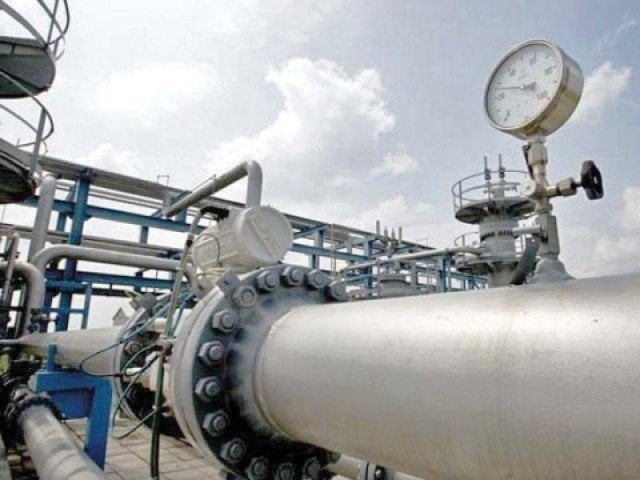As cheaper gas resources dwindle, low tariffs may not be sustainable
There are proposals to stop expansion of gas network, new connections in residential sector

There are proposals to stop expansion of gas network, new connections in residential sector.
PHOTO: FILE
The residential gas tariff is quite high in the region, say in Bangladesh and India. In India, there is a drive now to increase natural gas supplies to the domestic sector and compressed natural gas (CNG) stations. This is the trend that started in 2008 but now is going on a very fast track. The target is to reach 10 million domestic consumers by 2021. In this respect, high volumes of liquefied natural gas (LNG) are being imported to meet the emanating demand.
In Pakistan, piped natural gas is being supplied since the 1950s and a network spread over more than 100,000 km has been laid. There are 7.5 million domestic consumers as against less than 10,000 industrial consumers, who reportedly are showing a negative trend, reflecting de-industrialisation, which has contributed to increasing the current account deficit.
Gas crisis deepens as LNG terminal shut for maintenance
Definitely, gas supplies to residential consumers have contributed to better living conditions at homes through a clean, convenient and affordable cooking fuel. However, among technical and bureaucratic circles, a sentiment is growing against the residential use, largely based on perceived unaccounted for gas (UFG) and low residential tariff.
Many believe that gas ought to go to the industry and chemical and fertiliser sectors. Jury is, however, still out as to where lay the majority of gas theft, residential or industrial and CNG sector. However, as cheaper local gas resources dwindle and there is increasing influx of expensive LNG (which may not be avoided even local gas is likely to become more expensive), current very low rates may not be sustainable.
Following are the sources of pressure on gas companies and their tariff: Firstly, high UFG losses, which are increasing and not decreasing; secondly, sudden depreciation of the rupee; and thirdly, low gas prices for the fertiliser and export sectors. These subsidies ought to come from the government budget, rather than gas consumers. Reportedly, the export sector subsidy is coming out of the government budget.
A comparison of the current tariff (Sept 2018) with the last one of December 2016 shows a tariff increase of 15-30% in the slabs of small consumers and of 143% in the large slab of 500 M3 and above consumption of gas per month. It is this latter group which is complaining, whose monthly bill of Rs10,000 has inflated to Rs25,000.
The problem is that in this category, some middle-class families may also fall, who are in the combined family system, where several households are living in one, may be a larger, house.
Comparison with region
Let us compare the gas tariff in Pakistan with other countries in the region. In Bangladesh, it is 750 taka per month for one gas-burner home and 800 taka for two-burner home. In this category, there are no meters. This means an average of Rs1,300 per month (at Rs138 per US dollar and 83.81 taka). In Pakistan, the corresponding family pays only Rs250-500 per month.
In India, there is a flat rate in Gujarat of Pakistani Rs1,460 per million British thermal units (mmbtu), which is equal to the highest domestic tariff in Pakistan. Various gas tariffs are Pakistani Rs121, 127, 264, 275, 780 and 1,460 per mmbtu. For the sake of comparison, the LNG price these days is Pakistani Rs1,656 per mmbtu while local gas is produced at half the LNG rate or lesser.
Sindh threatens to stop gas supply to other provinces
It becomes clear that the prevailing gas tariff in Pakistan is quite low as compared to both India and Bangladesh. The highest domestic tariff at which people are crying hoarse is a normal tariff in India.
In Bangladesh, the lifeline poor consumer pays up to three times than the corresponding rate in Pakistan, which is a more egalitarian society, one may ask. However, in India, there is a liquefied petroleum gas (LPG) subsidy scheme for the poor - a subsidy of Indian Rs200 per cylinder per month.
Small vs large consumers
The residential sector consumes some 34% of the gas supplied by the two gas companies - SSGC and SNGPL. There are 7.59 million domestic consumers, out of which very small consumers are 7 million and very large consumers, who have been affected by huge bills, are only 120,000 families, which also show the skewed income distribution in Pakistan.
Gas reserves: Vessels arrive for offshore drilling in Pakistan
However, you can extract the same amount of money, say Rs120 million per month, if Rs10,000 per month is extracted from large consumers or Rs200 per month is received from small consumers.
So, the current problem is really of the large category, where an abnormal increase in tariff has been levied, from Rs600 to Rs1,460 per mmbtu. Some reduction, say of bringing this tariff to Rs1,000 per mmbtu, may not be that disturbing as hardly 120-150,000 consumers may fall in this category.
To the poor lifeline consumers, gas is being given at Rs121 per mmbtu. This is virtually free as Rs121 is the distribution cost alone and thus the commodity is free. This used to be done in Iran, Saudi Arabia and Venezuela for petrol and high-speed diesel prices, but no more.
It feels good to provide free things to the poor, but is it sustainable? The price has to have some relevance with the cost. As a consequence, already there are proposals to stop the expansion of gas network and new connections in the residential sector. No more poor consumers will be added as a consequence.
Thus, one has to consider welfare consequences of a larger number of beneficiaries with higher prices with lesser number of poor consumers at low prices. Already, gas is supplied only to 20% of the population.
Some gradual revision in the slab price for poor gas consumers is in order. The poor pays market price for all other things he buys. This is not to suggest that if there is an advantage to the poor, it should be taken away. However, there should be some adjustment, reflecting the exchange rate difference to the minimum.
It would be politically very difficult as almost 7 million families are involved and this is already quite an inflationary year due to depreciation.
The writer is the former member energy of the Planning Commission
Published in The Express Tribune, February 18th, 2019.
Like Business on Facebook, follow @TribuneBiz on Twitter to stay informed and join in the conversation.


1735506669-0/image-(16)1735506669-0-208x130.webp)
















COMMENTS
Comments are moderated and generally will be posted if they are on-topic and not abusive.
For more information, please see our Comments FAQ